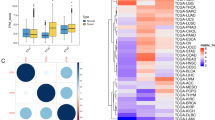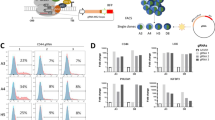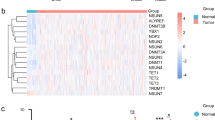Abstract
Cancer is a progressive disease in which a tumor cell temporally develops qualitatively new transformation related phenotypes or a further elaboration of existing transformation associated properties. Subtraction hybridization identified a novel gene associated with transformation progression in mutant adenovirus type 5, H5ts125, transformed rat embryo cells, progression elevated gene-3 (PEG-3). To define the mechanism by which expression of PEG-3 is enhanced as a function of cancer progression a 5′-flanking promoter region of ∼2.0-kb, PEG-Prom, was isolated, cloned and characterized. The full-length and various mutated regions of the PEG-Prom were linked to a luciferase reporter construct and evaluated for promoter activity during cancer progression. These assays demonstrate a requirement for AP1 and PEA3 sites adjacent to the TATA box region of PEG-3 in mediating basal promoter activity and the enhanced expression of PEG-3 in progressed H5-ts125-transformed rat embryo cells. An involvement of AP1 and PEA3 in PEG-3 regulation was also confirmed by electrophoretic mobility shift assays (EMSA) and transfection studies with cJun and PEA3 expression vectors. Our findings document the importance of both AP1 and PEA3 transcription factors in mediating basal and elevated expression of PEG-3 in H5ts125-transformed rat embryo cells displaying an aggressive and progressed cancer phenotype.
This is a preview of subscription content, access via your institution
Access options
Subscribe to this journal
Receive 50 print issues and online access
$259.00 per year
only $5.18 per issue
Buy this article
- Purchase on SpringerLink
- Instant access to full article PDF
Prices may be subject to local taxes which are calculated during checkout








Similar content being viewed by others
References
Angel P and Karin M. . 1991 Biochim. Biophys. Acta 1072: 129–157.
Babiss LE, Zimmer SG and Fisher PB. . 1985 Science 228: 1099–1101.
Bishop JM. . 1991 Cell 64: 235–248.
Brown TA and McKnight SL. . 1992 Genes and Develop. 6: 2502–2512.
De Cesare D, Palazzolo M and Blasi F. . 1996 Oncogene 13: 2551–2562.
Dignam JM, Lebovitz RM and Roeder RG. . 1983 Nucl. Acids Res. 11: 1475–1489.
D'Orazio D, Besser D, Marksitzer R, Kunz C, Hume DA, Kiefer B and Nagamine Y. . 1997 Gene 201: 179–187.
Duigou GJ, Babiss LE and Fisher PB. . 1989 NY Acad. Sci. 567: 302–306.
Duigou GJ, Babiss LE, Iman DS, Shay JW and Fisher PB. . 1990 Mol. Cell. Biol. 10: 2027–2034.
Duigou GJ, Su Z-z, Babiss LE, Driscoll B, Fung YKT and Fisher PB. . 1991 Oncogene 6: 1813–1824.
Edwards DR, Rocheleau H, Sharma RS, Wils AJ, Cowie A, Hassell JA and Heath JK. . 1992 Biochem. Biophys. Acta 1171: 41–55.
Fisher PB. . 1984 Tumor Promotion and Cocarcinogenesis In Vitro, Mechanisms of Tumor Promotion. Slaga T. J. (ed). CRC Press, Inc., Boca Raton, FL pp. 57–123.
Fisher PB, Weinstein IB, Eisenberg D and Ginsberg HS. . 1978 Proc. Natl. Acad. Sci. USA 75: 2311–2314.
Fisher PB, Goldstein NI and Weinstein IB. . 1979a Cancer Res. 39: 3051–3057.
Fisher PB, Dorsch-Hasler K, Weinstein IB and Ginsberg HS. . 1979b Nature 281: 591–594.
Fisher PB, Bozzone JH and Weinstein IB. . 1979c Cell 18: 695–705.
Fisher PB, Babiss LE, Weinstein IB and Ginsburg HS. . 1982 Proc. Natl. Acad. Sci. USA 79: 3527–3531.
Gopalkrishnan RV, Christiansen K, Goldstein NI, DePinho RA and Fisher PB. . 1999 Nucl. Acids Res. 27: 4775–4782.
Gutman A and Wasylyk B. . 1990 EMBO J. 9: 2241–2246.
Hartwell LH and Kastan MB. . 1994 Science 266: 1821–1828.
Higashino F, Yoshida K, Noumi T, Seiki M and Fujinaga K. . 1995 Oncogene 10: 1461–1463.
Jiang H and Fisher PB. . 1993 Mol. Cell. Different. 1: 285–299.
Kang D-c, LaFrance R, Su Z-z and Fisher PB. . 1998a Proc. Natl. Acad. Sci. USA 95: 13788–13793.
Kang D-c, Motwani M and Fisher PB. . 1998b Intl. J. Oncology 13: 1117–1126.
Karin M, Liu Z and Zandi E. . 1997 Curr. Opin. Cell Biol. 9: 240–246.
Kohn EC and Liotta LA. . 1995 Cancer Res. 55: 1856–1862.
Knudson AG. . 1993 Proc. Natl. Acad. Sci. USA 90: 10914–10921.
Levine AJ. . 1993 Annu. Rev. Biochem. 62: 623–651.
Liotta LA, Steeg PG and Stetler-Stevenson WG. . 1991 Cell 64: 327–336.
Matrisian LM and Bowden GT. . 1990 Sem. Cancer Biol. 1: 107–115.
Matrisian LM. . 1994 Ann. NY Acad. Sci. 91: 10129–10133.
Macleod K, Leprince D and Stehelin D. . 1992 Trends Biochem. Sci. 17: 251–256.
Nerlov C, De Cesare D, Pergola F, Caracciolo A, Blasi F, Johnsen M and Verde P. . 1992 EMBO J. 11: 4573–4582.
Olive M, Krylov D, Echlin DR, Gardner K, Taparowsky E and Vinson C. . 1997 J. Biol. Chem. 272: 18586–18594.
Reddy PG, Su Z-z and Fisher PB. . 1993 Chromosome and Genetic Analysis, Methods in Molecular Genetics. Adolph K. W. (ed). Vol 1. Academic Press, Inc., Orlando, FL pp. 68–102.
Seth A, Ascione R, Fisher RJ, Mavrothalassitis GJ, Bhat NK and Papas TS. . 1992 Cell Growth Different. 3: 327–334.
Sirum-Conolly K and Brinckerhoff CE. . 1991 Nucl. Acids Res. 19: 335–341.
Stacey KJ, Fowles LF, Colman MS, Ostrowski MC and Hume SA. . 1995 Mol. Cell. Biol. 15: 3430–3441.
Su Z-z, Shen R, O'Brian CA and Fisher PB. . 1994 Oncogene 9: 1123–1132.
Su Z-z, Yemul S, Estabrook A, Zimmer SG, Friedman RM and Fisher PB. . 1995 Intl. J. Oncology 7: 1279–1284.
Su Z-z, Shi Y and Fisher PB. . 1997 Proc. Natl. Acad. Sci. USA 94: 9125–9130.
Su Z-z, Goldstein NI, Jiang H, Wang MN, Duigou GJ, Young CSH and Fisher PB. . 1999 Proc. Natl. Acad. Sci. USA 96: 15115–15120.
Vogelstein B and Kinzler KW. . 1993 Trends Genet. 9: 138–141.
Wasylyk C, Flores P, Gutman A and Wasylyk B. . 1989 EMBO J. 8: 3371–3378.
Wasylyk B, Hahn SL and Giovane A. . 1993 Eur. J. Biochem. 211: 7–18.
Acknowledgements
We thank Drs Rahul Gopalkrishnan and Dong-chul Kang for critical comments on this manuscript. We are grateful to Drs Michael Birrer and Paul Dent for providing the cJun and TAM67 expression vectors and Dr John Hassell for providing the PEA3 expression vector. This research was supported in part by National Institutes of Health Grants CA35675 and CA74468, the Chernow Endowment and the Samuel Waxman Cancer Research Foundation. PB Fisher is the Michael and Stella Chernow Urological Cancer Research Scientist.
Author information
Authors and Affiliations
Rights and permissions
About this article
Cite this article
Su, Zz., Shi, Y. & Fisher, P. Cooperation between AP1 and PEA3 sites within the progression elevated gene-3 (PEG-3) promoter regulate basal and differential expression of PEG-3 during progression of the oncogenic phenotype in transformed rat embryo cells. Oncogene 19, 3411–3421 (2000). https://doi.org/10.1038/sj.onc.1203666
Received:
Revised:
Accepted:
Published:
Issue date:
DOI: https://doi.org/10.1038/sj.onc.1203666
Keywords
This article is cited by
-
MRI detection of the malignant transformation of stem cells through reporter gene expression driven by a tumor-specific promoter
Stem Cell Research & Therapy (2021)
-
Tumor-specific imaging through progression elevated gene-3 promoter-driven gene expression
Nature Medicine (2011)
-
IL-6 promotes prostate tumorigenesis and progression through autocrine cross-activation of IGF-IR
Oncogene (2011)
-
Discoidin domain receptor 2 is associated with the increased expression of matrix metalloproteinase-13 in synovial fibroblasts of rheumatoid arthritis
Molecular and Cellular Biochemistry (2009)
-
A cancer terminator virus eradicates both primary and distant human melanomas
Cancer Gene Therapy (2008)



